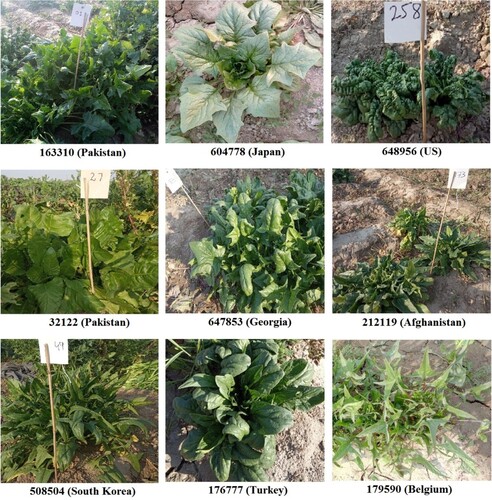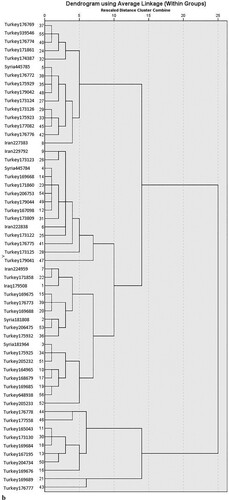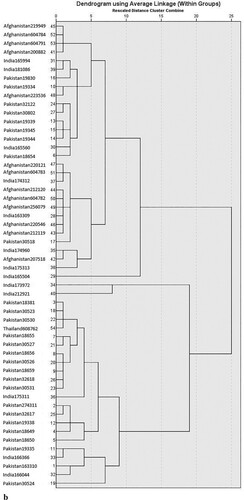Abstract
Spinach is a highly nutritive and medicinally important leafy vegetable cultivated in many countries worldwide. Diversity in the gene pool of a species may affect the adaptability to a new environment as well as to develop new varieties more tolerant to stress and pathogens. To assess the genetic variability of species, morphological traits are considered as the simplest markers. Therefore, a field experiment was conducted to explore the genetic diversity of spinach germplasm from 30 different countries, using agro-morphological traits. Data was based on 21 morphological characters, analyzed by multivariate statistical tools. Plant height, petiole attitude, leaf size, and leaf shape were the characters showing significant variations. Based on geographical distribution, the germplasm of Turkey and China was found to be more diverse, followed by Afghanistan and Pakistan. Results concluded that the studied germplasm possessed an important source of highly diverse agronomic traits that should be conserved for future spinach breeding programs.
1. Introduction
Spinach (Spinacia oleracea L.) is an edible and annual functional food species belonging to the family Amaranthaceae. It was originated from Iran and first declared as a herb of Persia by the Chinese [Citation1]. Currently, China, Turkey, United States, Japan, and Indonesia are considered the largest producers of spinach [Citation2]. In Pakistan, its production is almost 108,725 tons of spinach covering an area of about 8820 hectares [Citation3]. Compared to major spinach producing countries, its production in Pakistan is very low. To fulfill the basic needs of people, Pakistan is taking an import of around 4500 kilograms of spinach annually from Belgium and 2000 kilograms from China which is costing almost 0.49 M PKR and 0.17 M PKR, respectively [Citation3]. A large number of nutrients have been reported in spinach including vitamins, minerals, antioxidants, carotenoids, steroids, apocyanin, flavonoids and p-coumaric acid [Citation4]. Spinach contains highly active antioxidants that work against cancer and diabetes, nitrates for maintaining blood pressure and vitamin K1 for blood clotting [Citation4–6]. On the basis of its medicinal properties, a herbal product, namely Appethyl (Green Leaf Medical, Stockholm, Sweden), has also been designed specifically to suppress appetite and reduce weight [Citation7].
Diversity in the gene pool of a species may affect the ability of a species to survive and better adapt to a new environment. Moreover, this diversity is also important in the aspect to develop new varieties, more tolerant to stress conditions and pathogen attack [Citation8]. Utilization of the genetic potential of crop germplasm requires detailed knowledge about its genetic variation [Citation9]. To study the genetic diversity of a species, a number of markers have been used. Morphological traits controlled by a single locus can be used as genetic markers provided their expression is reproducible over a range of environments. Besides, these can be visualized easily without having the need of other complex techniques [Citation10]. The diversity of spinach has been studied worldwide but the studies are restricted to accessions collected from different regions of one country only [Citation6,Citation11,Citation12]. Moreover, most of the researchers have used molecular markers to assess genetic diversity, but have little or no information about the agro-morphological traits. Therefore, the study was planned to assess the genetic diversity of worldwide spinach germplasm, covering a large number of countries by using agro-morphological traits and to detect groups of genetically distinct morphological types among all.
2. Materials and methods
Morphological analysis of worldwide spinach germplasm was done based on different agro-morphological traits of the crop. The study was done in the field area of Vegetable Research Institute of Ayub Agriculture Research Institute, Faisalabad, Pakistan (31°25′0″N73°5′28″E). The first field experiment was conducted during Fall 2017 and the second in Fall 2018. The experiment was performed using Random Complete Block Design (RCBD). Seeds of 200 spinach accessions from 30 different countries and 4 continents of the world were obtained from gene banks of National Agriculture Research Center (NARC) Islamabad, Pakistan, and United States Department of Agriculture (USDA). The accessions were comprising of 27 local and 173 international types of germplasm.
2.1. Field preparation
Soil tillage was done at the field area by shallow ploughing followed by rotary harrowing. The area of each plot was 100 × 75 m2 containing 41 rows of 100 cm length and a width of 75 cm. The texture of the soil was loamy with a pH of 7.9. Other properties of soil were determined at two levels of soil. At a depth of 0–15 cm, the properties of the soil were as follows: electrical conductivity (EC), 5.47 mS/cm; available phosphorus, 17.23 ppm; available potassium, 570 ppm; saturation, 36%; and organic matter, 0.83%. While at the depth of 15–30 cm, soil properties were as follows: EC, 5.05 mS/cm; available phosphorus, 15.10 ppm; available potassium, 550 ppm; saturation, 35%, and organic matter, 0.67%. The average temperature recorded in the month of sowing (i.e. October 2018) was 32.9°C maximum and 18.4°C minimum. Relative humidity was observed to be 73.5% in the morning and 46.7% in the evening. Moreover, an average of 0.6 mm rainfall was recorded in the whole month of sowing. Sowing was performed manually in 41 rows with a spacing of 10 cm per plant. The depth of seed was kept at 1–1.5 cm. A number of 25 healthy seeds per accession were sown in the rows. Hand weeding was done at regular intervals. Fertilizers were applied comprising of a basal dose of diammonium phosphate (DAP) and then nitrogen application.
2.2. Data analysis
Data were recorded at different stages of life cycle of plants according to the standard morphological descriptors of spinach by European Cooperative Programme for Plant Genetic Resources (ECPGR) and Federal Seed Certification and Registration Department, Ministry of Food, Agriculture and Livestock, Government of Pakistan, Islamabad. Data were based on 6 quantitative and 15 qualitative characters (Supplementary Table S1). Qualitative data were represented in the form of frequency distribution. Quantitative data were analyzed by simple descriptive statistics including mean, variance, standard deviation and coefficient of variation. Correlation and cluster analyses were done by computerized software IBM SPSS Statistics Base 22.0. Principle component analysis was performed by computerized software XLSTAT.
3. Results and discussion
The agro-morphological study is the simplest and easiest way for the taxonomic description of plants [Citation13]. Moreover, this description is an essential requirement for an effective application of plant material by each of the plant breeder [Citation14]. Field experiments were conducted for morphological characterization of spinach germplasm collected from 30 different countries belonging to 4 major continents of the world. The study was based on 21 morphological traits including 6 quantitative and 15 qualitative. Significant variation was observed among a number of morphological traits, showing a high degree of genetic polymorphism in the accessions. It has shown the possibility to get desirable plant characters in selective accessions, in order to fulfill the demand of a plant breeder [Citation15].
3.1. Qualitative characters
Qualitative characters are considered as important markers in describing the physical appearance of a plant [Citation16]. A lot of factors are influenced by these physically observed characters including the natural selection of plants, preference of consumers as well as socio-economic setup of a particular place [Citation17]. The present study was based on 15 qualitative characters including seed size, color, shape, spines, petiole shape, anthocyanin, attitude, leaf color, anthocyanin, blistering, lobing, glossiness, apex, margin undulation and bolting period. Considerable variation was observed among leaf features of accessions like anthocyanin, blistering and lobing (Figure ). The frequency of all the quantitative traits is shown in Supplementary Table S2. Seeds of accessions varied in terms of color, shape and size. Accessions of Pakistan, India, Syria and the US had the greatest variety bearing all the three types of seed sizes (small, medium and bold). Maximum accessions were found to have seeds of medium size while only 25% of accessions had bold seed size. According to Chaudhry and Ikram-Ullah [Citation18], maximum crop yield could be observed as a result of the sowing of bold seeds.
There was no sign of anthocyanin in petiole and leaf of accessions from the US. Blistering was most common in Serbia, Germany, Netherland and some US accessions. In terms of high lobation, Indian accessions were found to be most prominent while that of the US were having weakly lobed leaves. On the basis of petiole attitude, most of the accessions were erect including the germplasm of India, Afghanistan, South Korea, Mongolia, Taiwan and Belgium. The semi-erect attitude was found mostly in the germplasm of Pakistan, Iran and Ethiopia while horizontal attitude was prominent in France germplasm. Japan and the US had all three types of petiole attitude in spinach. The bolting period of accessions also varied greatly, as some of the accessions bolted very early, some very late. One accession from Pakistan (30,523), two from Belgium (179,596 and 179,597) and seven from India (163,309, 165,504, 165,560, 166,044, 166,366, 173,972 and 175,312) bolted very early. About 15% of accessions were not bolted till the start of summer. Arif et al. [Citation19] also found considerable variation among bolting periods, representing it as one of the selection criteria for the assessment of spinach germplasms. Early bolting germplasms could be useful for plant breeders, due to their significant association with harvesting time; such accessions could be useful in future breeding programs.
3.2. Quantitative characters
Quantitative characters are also important markers, especially those which are showing high variability [Citation20]. The reason might be that the expression of these characters is controlled by multiple alleles [Citation21]. The present study was based on 6 quantitative traits including percent germination, plant height, petiole thickness, petiole length, leaf length and width. Variation among the data of both years was represented in terms of mean value, variance, standard deviation and coefficient of variation (CV) (Tables and ). The characters showing above 20% of the coefficient of variation could be used as reliable markers for the characterization of accessions [Citation22]. In the present results, all quantitative characters showed high values of CV ranging from 30.8% (leaf length) to 66.9% (plant height). Most of the accessions had a medium range of plant heights while that of the US, France and the Netherland were having smaller heights. Arif et al. [Citation19] also found considerable variation among plant heights, stating it as a useful trait for breeders. Percent germination was found to be mixed among accessions of different countries. Both of these traits could be considered helpful in the improvement of crops. Minimum variability was found in stem thickness for both years, i.e. variance of 4.19 for 2017–2018 and 2.71 for 2018–2019. Indian and Ethiopia germplasm was mostly showing the least stem thickness while US germplasm had the thickest stems.
Table 1. Descriptive statistical analysis of quantitative characters of spinach accessions (Year: 2017–2018).
Table 2. Descriptive statistical analysis of quantitative characters of spinach accessions (Year: 2018–2019).
3.3. Correlation analysis
Association between various economically important traits could lead toward a better understanding of the relationship of characters eventually providing an improved strategy for any crop [Citation23,Citation24]. Especially when dealing with multiple characters, it might be difficult to measure each. Therefore, a higher correlation of characters could be used to estimate other traits [Citation25]. In order to assess the significant trait association, correlation coefficient analysis was done for different quantitative traits (Supplementary Tables S3 and S4). Leaf length and leaf width were found to be highly correlated showing a significant positive association (up to 74%). Similar findings were reported by Arif et al. [Citation19] and Varalakshmi and Devaraju [Citation26], for these characters. A positive correlation of traits represents that the improvement of one can improve the other trait too [Citation27]. Varalakshmi and Devaraju [Citation26] also picked these types of leaf characters for the indirect selection of germplasm as these are directly linked with the increase or decrease of yield, in the case of leafy vegetables. Alternatively, leaf width and seed germination showed a minimum correlation (up to 8%), representing the least significance of their interrelationship.
3.4. Principle component analysis
Describing an extensive data set for the assessment of a number of variables could be unmanageable [Citation28]. Principle component analysis (PCA) is a reliable multivariate technique to convert a large data set in the form of a few factors that include several inter-correlated variables [Citation29]. This analysis can represent the extent of variation among a large number of germplasm by reducing the amount of data [Citation25]. A number of studies have shown the importance of this analysis for comprehensive crop evaluation [Citation28–31]. Therefore, the analysis was carried out to determine the main differentiating traits causing variation among 200 spinach accessions. According to the set criteria, eigenvalues greater than one were considered to determine the PC score of each factor [Citation32]. The more the eigenvalue of a component, the more it will be representative of the data [Citation6]. The overall data were reduced to seven factors or principal components (PC) representing about 72–75% of the total variability in both years (Tables and ). Usually, the first component contributes toward maximum variance while the rest of the factors justify the remaining amount of variance [Citation25]
Table 3. Principle component analysis of spinach accessions based on agro-morphological traits (Year: 2017–2018).
Table 4. Principle component analysis of spinach accessions based on agro-morphological traits (Year: 2018–2019).
Each factor reflected the PC values of different traits, showing their importance towards the overall variability. Only highly loaded traits, represented in the form of eigenvectors, were considered for further explanation [Citation29]. PC1 represented leaf lobing, seed shape and spines as the main loading factors with eigenvectors in the range of 0.32–0.35 and 25% overall contribution rate. PC2 contributed 12–16% with petiole length, leaf length and width as the higher loading factors (0.3–0.4). The contribution of PC3 was up to 9% mainly due to leaf and stem anthocyanin (0.4 eigenvector). PC4 was representing 7% variability with leaf length and width as the loading factors (0.4). The contribution level of PC5 was up to 6%, mainly due to leaf and stem anthocyanin with 0.4 loading value. The contribution factors of PC6 were petiole shape and seed color with 0.4–0.5 eigenvectors, showing an overall 6% variability. PC7 was the least variability contributor (5%) representing seed color as the highest loading factor (0.6). PCA could help indicate the best representative traits that are responsible for observed genotypic variability [Citation29].
PCA of present results has indicated that seed, leaf and anthocyanin-related traits are the main variability contributing factors. Similar to this, Sabaghnia et al. [Citation1] also reported leaf trait as the most important factor contributing towards variability of spinach germplasm. Figures S1 and S2 represented biplot analyses showing variability among accessions based on their geographical locations and different morphological traits. This scatter plot is a two-dimensional representation of a large number of samples based on two major components leading towards the overall variability. Accumulation of variables in a closed region indicates the positive correlation among them [Citation25]. A similar plot was built by Arif et al. [Citation19] and Sabaghnia et al. [Citation1] to show the correlation of different morphological features. In the present results, the two main factors collectively represented 38–41% variability during both years of growth. The plant breeders might select the combination of morphological characters through PCA and then by plotting the main components in a single plot, germplasms closed to the ideal could be indicated [Citation33]. Based on the results of this analysis, the accessions were grouped into different clusters giving out the representative germplasm of different continents.
3.5. Cluster analysis
Grouping of a large number of accessions, based on multiple variables, is a reliable technique to determine the similarities and extent of differences among them [Citation34]. To represent such kind of relationship and characterize the most diverse germplasm, cluster analysis was performed for accessions of different continents (Figures ). A high level of diversity was observed among the accessions of South Asia and Southeast Asia especially in the countries of Pakistan and Afghanistan. Also, there was diversity among Indian accessions but most of them were bolted very early showing their ability of early seed production and short life cycle (Figure (a,b)). In the case of the cluster of West Asia, about 10–12 accessions of Turkey were separated in the form of a dominant cluster showing high germination rate, but comparatively smaller heights and dark green leaves with weak margin undulation (Figure (a,b)). Accessions of East Asia were split into two main clusters. One of the clusters, including accessions of Hong Kong (419,218), Taiwan (321,020), South Korea (508,504) and Japan (165,710, 804,780), had shown dominant features related to comparatively higher germination rate, medium to bold size of seeds and higher length-to-width ratio of the leaf (Figure (a,b)).
Figure 2. (a) Cluster Analysis of West Asia Spinach Accessions (Year: 2017–2018). (b) Cluster Analysis of West Asia Spinach Accessions (Year: 2018–2019).
Figure 3. (a) Cluster Analysis of South Asia and Southeast Asia Spinach Accessions (Year: 2017–2018). (b) Cluster Analysis of South Asia and Southeast Asia Spinach Accessions (Year: 2018–2019).
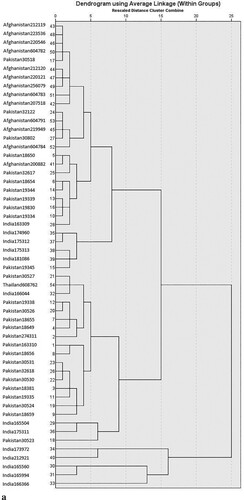
Figure 4. (a) Cluster Analysis of East Asia Spinach Accessions (Year: 2017–2018). (b) Cluster Analysis of East Asia Spinach Accessions (Year: 2018–2019).
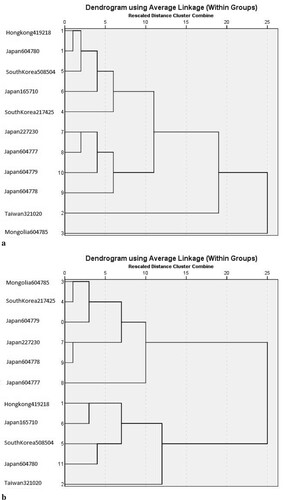
Figure 5. (a) Cluster Analysis of European Spinach Accessions (Year: 2017–2018). (b) Cluster Analysis of European Spinach Accessions (Year: 2018–2019).
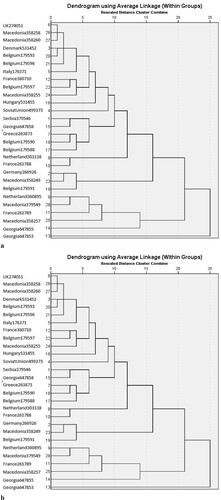
Figure 6. (a) Cluster Analysis of African and North American Spinach Accessions (Year: 2017–2018). (b) Cluster Analysis of African and North American Spinach Accessions (Year: 2018–2019).
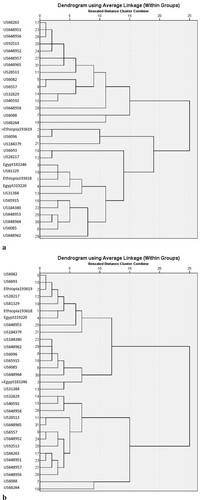
The cluster analysis indicates the extent of variability that could be useful for future breeding programs [Citation35]. Several authors have used this tool for morphological characterization of different species representing their intraspecific relationship [Citation1,Citation19,Citation28,Citation36]. Among the accessions of Europe, five accessions were clustered out from others including two from Georgia (647,855, 647,853), two from Macedonia (358,257, 379,549) and one from France (261,789). This clustering was found to be based on improved percent germination and weak leaf blistering (Figure (a,b)). Figure (a,b) shows two main clusters formed from accessions of Africa and North America; 14 North American accessions were found to be different from all other accessions in terms of improved percent germination, medium plant height, no anthocyanin and weak lobation with a round leaf tip. On the whole, Asian countries especially Pakistan, India, Afghanistan, China and Turkey represented a highly diverse germplasm. This diversity was represented by a number of prominent morphological markers including seed size, germination rate, plant height and leaf features. However, the clusters showed no significant relationship between the genetic variability and geographical location of spinach accessions, as the accessions from one origin were found to be dispersed in more than one cluster. Similar findings were reported by Ebadi-Segheloo et al. [Citation15] for their study on Iranian spinach landraces and Rashid et al. [Citation4] for the study on Pakistani spinach accessions.
4. Conclusion
The present report was the first one about the morphological characterization of 200 spinach accessions, covering 30 countries of 4 major continents of the world. Significant variation was observed among the accessions especially based on plant height and leaf features (both quantitative and qualitative). According to PCA, leaf, stem and anthocyanin were found to be the important traits in contributing variability. Cluster analysis showed high diversity in some of the accessions of Pakistan, India, Afghanistan, China and Turkey, though the grouping of accessions was independent of their geographical locations. Genetically diverse accessions of these countries could be selected for further exploration by advanced biochemical techniques. Moreover, a breeder might use these distinct lines to create new varieties with desired features, related to disease resistance ability, elevated antioxidant levels as well as good quality and quantity of the crop.
Supplemental Material
Download MS Word (1.1 MB)Disclosure statement
No potential conflict of interest was reported by the author(s).
References
- Sabaghnia N, Asadi-Gharneh HA, JanMohammadi M. Genetic diversity of spinach (Spinacia oleracea L.) landraces collected in Iran using some morphological traits. Acta Agriculturae Slovenica. 2014;103(1):101–111.
- FAO. (2011). Food and agriculture organization of the united nations. FAO STAT database. http://faostat.fao.org/.
- Ministry of National Food Security. (2017–2018). Ministry of national food security and research, Islamabad Pakistan. http://www.mnfsr.gov.pk/userfiles1/file/YearBook2007-18.
- Rashid M, Yousaf Z, Haider MS, et al. Genetic diversity of functional food species Spinacia oleracea L. by protein markers. Nat Prod Res. 2014;28(11):782–787.
- Gunnars K. Spinach 101: nutrition facts and health benefits. Iceland: Health-line Newsletter; 2019.
- Avşar B. Thesis on: genetic diversity of Turkish spinach cultivars. Izmir, Turkey: Izmir Institute of Technology; 2011.
- Banks S. (2017). Appethyl review – does this dietary supplement work?
- Goktay M. Thesis on: characterization of world spinach genetic collection by using molecular markers. Izmir, Turkey: Izmir Institute of Technology; 2015.
- Morelock TE, Correll JC. Spinach breeding. In: J Prohens, F Nuez, editors. Vegetables I. New York: Springer; 2008. p. 183–212.
- Kumar LS. DNA markers in plant improvement: an overview. Biotechnol Adv. 1999;17(2-3):143–182.
- Hu J, Mou B, and Vick M, et al. Genetic diversity of 38 spinach (Spinacia oleracea L.) germplasm accessions and 10 commercial hybrids assessed by TRAP markers. Genet Resour Crop Evol. 2007;54:1667–1674.
- Kuwahara K, Suzuki R, Ito Y, et al. An analysis of genetic differentiation and geographical variation of spinach germplasm using SSR markers. Plant Genet Resour Charact Util. 2014;12(2):185–190.
- Smith SE, Al-Doss A, Warburton M. Morphological and agronomic variation in North African and Arabian alfalfas. Crop Sci. 1991;31:1159–1163.
- Barro-Kondombo C, Sagnard F, Chantereau J, et al. Genetic structure among sorghum landraces as revealed by morphological variation and microsatellite markers in three agroclimatic regions of Burkina Faso. Theor Appl Genet. 2010;120:1511–1152.
- Ebadi-Segheloo A, Mohebodini M, Janmohammadi M, et al. The use of some morphological traits for the assessment of genetic diversity in spinach (Spinacia oleracea L.) landraces. Plant Breed Seed Sci. 2014;69(1):69–80.
- Kurlovich BS. Species and intraspecific diversity of white, blue and yellow lupins. Plant Genet Res Newsl. 1998;115:23–32.
- Ghafoor A, Ahmad Z, Qureshi AS, et al. Genetic relationship in Vigna mungo (L.) Hepper and V. radiata (L.) R. Wilczek based on morphological traits and SDS-PAGE. Euphytica. 2002;123(3):367–378.
- Chaudhry AU, Ullah MI. Influence of seed size on yield, yield components and quality of three maize genotypes. J Biol Sci. 2001;1:150–151.
- Arif M, Jatoi SA, Rafique T, et al. Genetic divergence in indigenous spinach genetic resources for agronomic performance and implication of multivariate analyses for future selection criteria. Technol Dev. 2013;32:7–15.
- Iqbal J. Thesis on: genetic diversity assessment of maize (Zea mays L.) germplasm based on morphological, biochemical and molecular markers. Islamabad: Quaid-i-Azam University; 2015.
- Amurrio JM, de Ron AM, Zeven AC. Numerical taxonomy of Iberian pea landraces based on quantitative and qualitative characters. Euphytica. 1995;82:195–205.
- Farahani M, Salehi-Arjmand H, Khadivi A, et al. Chemical characterization and antioxidant activities of Morus alba var. nigra fruits. Sci Hortic. 2019;253:120–127.
- Eivazi AR, Naghavi MR, Hajheidari M, et al. Assessing wheat (Triticum aestivum L.) genetic diversity using quality traits, amplified fragment length polymorphisms, simple sequence repeats and proteome analysis. Ann Appl Biol. 2008;152:81–91.
- Saleem U, Khaliq I, Tariq M, et al. Phenotypic and genotypic correlation coefficients between yield and yield components in wheat. J Agricul Res. 2006;44:1–8.
- Fereidoonfar H, Salehi-Arjmand H, Khadivi A, et al. Morphological variability of sumac (Rhus coriaria L.) germplasm using multivariate analysis. Ind Crops Prod. 2018;120:162–170.
- Varalakshmi B, Devaraju. Genetic variability in Indian spinach (Basella alba L.). J. Hort. Sci. 2010;5:21–24.
- Yucel C, Baloch FS, Ozkan H. Genetic analysis of some physical properties of bread wheat grain (Triticum aestivum L. em Thell). Turk J Agric For. 2009;33:525–535.
- Khadivi A. Phenotypic characterization of Elaeagnus angustifolia using multivariate analysis. Ind Crops Prod. 2018;120:155–161.
- Pachauri AK, Sarawgi AK, Bhandarkar S, et al. Agro-morphological characterization and morphological based genetic diversity analysis of rice (Oryza sativa L.) germplasm. J Pharmacogn Phytochem. 2017;6(6):75–80.
- Loko LEY, Orobiyi A, Adjatin A, et al. Morphological characterization of common bean (Phaseolus vulgaris L.) landraces of Central region of Benin Republic. J Plant Breed Crop Sci. 2018;10(11):304–318.
- Shen G, Girdthai T, Liu ZY, et al. Principal component and morphological diversity analysis of Job’s-tears (Coix lacryma-jobi L.). Chil J Agric Res. 2019;79(1):131–143.
- Brejda JJ, Moorman TB, Karien DL, et al. Identification of regional soil quality factors and Indicators I. central and Southern high plains. Soil Sci Soc Am J. 2000;64:2115–2124.
- Mohebodini M, Sabaghnia N, Behtash F, et al. Principal component analysis of some quantitative and qualitative traits in Iranian spinach landraces. Proc Latv Acad Sci B. Nat Exact Appl Sci. 2017;71(4):307–310. De Gruyter Open.
- White JW, Andrade-Sanchez P, Gore MA, et al. Field-based phenomics for plant genetics research. Field Crop Res. 2012;133:101–112.
- Sultana T, Ghafoor A, Ashraf M. Geographic pattern of diversity of cultivated lentil germplasm collected from Pallistanas assessed by protein assays. Acta Biol Crac Ser Bot Pol. 2006;48:77–84.
- Boampong R, Aboagye LM, Nyadanu D, et al. Agro-morphological characterization of some taro (Colocasia esculenta (L.) Schott.) germplasms in Ghana. J Plant Breed Crop Sci. 2018;10(8):191–202.

